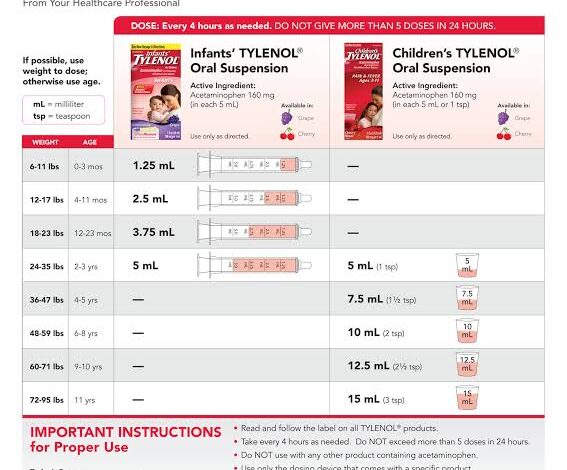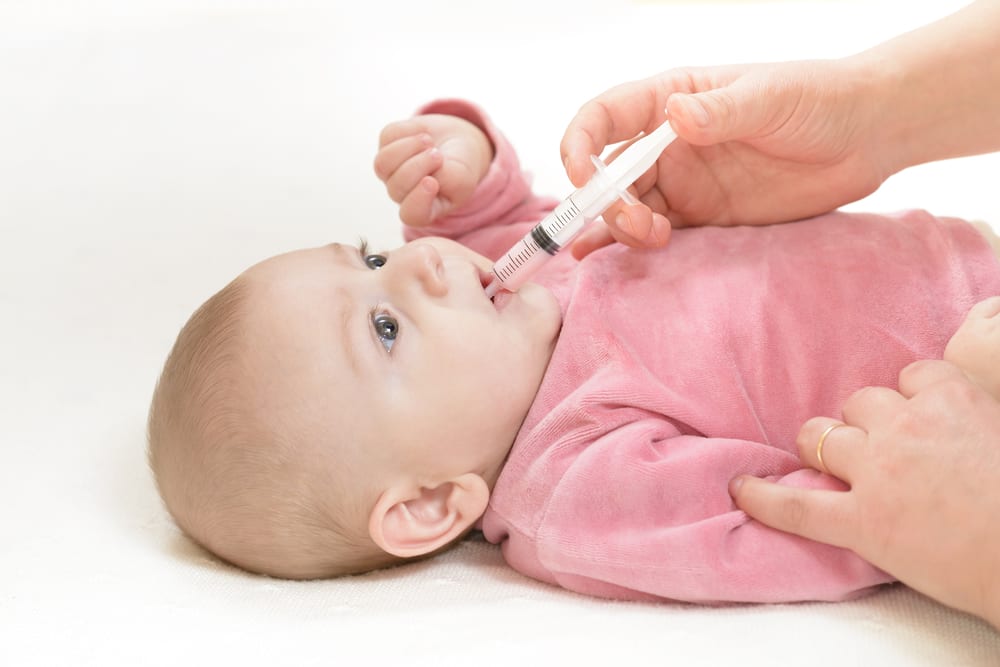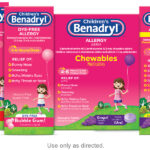Children and Infant Tylenol Dosage Chart

Tylenol is a brand of acetaminophen, an analgesic (pain reliever) and antipyretic (fever reducer) used for treating pain and fever associated with many conditions. Tylenol is available in generic form and over-the-counter (OTC).
Taking Tylenol (acetaminophen) can help children with colds and fever feel better. As with all drugs, it is important to give children the correct dose. Acetaminophen is safe when taken as directed. But, taking too much of this medicine can be harmful.
An infant’s weight needs to be exact for the dosing to be accurate. Determine your child’s weight before giving any medication.
| Do not exceed 5 doses in 24 hours | May Give Every | 10-11 lbs. 2-3 mo. | 12-17 lbs. 4-11 mo. | 18-23 lbs. 12-23 mo. | 24-35 lbs. 2-3 yr. | 36-47 lbs. 4-5 yr. | 48-59 lbs. 6-8 yr. | 60-71 lbs. 9-10 yr. |
| Children’s Liquid 160 mg/5 ml | 4 – 6 hours | 1.25 ml | 2.5 ml | 3.75 ml | 5 ml | 7.5 ml | 10 ml | 12.5 ml |
| Children’s Chewable Tablet 160 mg/tablet | 4 – 6 hours | – | – | – | 1 tab. | 1.5 tab. | 2 tab. | 2.5 tab. |
| Suppository 80 mg | 4 – 6 hours | – | 1 supp. | 1 1/2 supp. | 2 supp. | – | – | – |
| Suppository 120 mg | 4 – 6 hours | – | – | 1 supp. | 1 1/2 supp. | – | – | – |
| Suppository 325 mg | 4 – 6 hours | – | – | – | 1/2 supp. | 3/4 supp. | 1 supp. | – |

What is the proper Dosage of Tylenol for infants and children?
Children’s acetaminophen can be taken as liquid or chewable tablet.
If your child is under age 2 years, check with your health care provider before giving your child acetaminophen.
To give the correct dose, you will need to know your child’s weight.
You also need to know how much acetaminophen is in a tablet, teaspoon (tsp), or 5 milliliters (mL) of the product you are using. You can read the label to find out.
• For chewable tablets, the label will tell you how many milligrams (mg) are found in each tablet, such as 80 mg per tablet.
• For liquids, the label will tell you how many mg are found in 1 tsp or in 5 mL, such as 160 mg/1 tsp or 160 mg/5 mL.
For syrups, you will need some type of dosing syringe. It may come with the medicine, or you can ask your pharmacist. Make sure to clean it out after each use.
If your child weighs 24 to 35 lbs (10.9 to 15.9 kilograms):
• For syrup that says 160 mg/5 mL on the label: Give a dose: 5 mL
• For syrup that says 160 mg/1 tsp on the label: Give a dose: 1 tsp
• For chewable tablets that say 80 mg on the label: Give a dose: 2 tablets
If your child weighs 36 to 47 lbs (16 to 21 kilograms):
• For syrup that says 160 mg/5 mL on the label: Give a dose: 7.5 mL
• For syrup that says 160 mg/1 tsp on the label: Give a dose: 1 ½ tsp
• For chewable tablets that say 80 mg on the label: Give a dose: 3 tablets
If your child weighs 48 to 59 lbs (21.5 to 26.5 kilograms):
• For syrup that says 160 mg/5 mL on the label: Give a dose: 10 mL
• For syrup that says 160 mg/1 tsp on the label: Give a dose: 2 tsp
• For chewable tablets that say 80 mg on the label: Give a dose: 4 tablets
If your child weighs 60 to 71 lbs (27 to 32 kilograms):
• For syrup that says 160 mg/5 mL on the label: Give a dose: 12.5 mL
• For syrup that says 160 mg/1 tsp on the label: Give a dose: 2 ½ tsp
• For chewable tablets that say 80 mg on the label: Give a dose: 5 tablets
• For chewable tablets that say 160 mg on the label: Give a dose: 2 ½ tablets
If your child weighs 72 to 95 lbs (32.6 to 43 kilograms):
• For syrup that says 160 mg/5 mL on the label: Give a dose: 15 mL
• For syrup that says 160 mg/1 tsp on the label: Give a dose: 3 tsp
• For chewable tablets that say 80 mg on the label: Give a dose: 6 tablets
• For chewable tablets that say 160 mg on the label: Give a dose: 3 tablets
If your child weighs 96 lbs (43.5 kilograms) or more:
• For syrup that says 160 mg/5 mL on the label: Give a dose: 20 mL
• For syrup that says 160 mg/1 tsp on the label: Give a dose: 4 tsp
• For chewable tablets that say 80 mg on the label: Give a dose: 8 tablets
• For chewable tablets that say 160 mg on the label: Give a dose: 4 tablets
You may repeat the dose every 4 to 6 hours as needed. DO NOT give your child more than 5 doses in 24 hours.
If you are not sure how much to give your child, call your provider.
Proper Dosing of Suppositories
If your child is vomiting or will not take oral medicine, you can use suppositories. Suppositories are placed in the anus to deliver medicine.
You can use suppositories in children older than 6 months. Always check with your provider before giving any medicine to children under 2 years old.
This medicine is given every 4 to 6 hours.
If your child is 6 to 11 months:
• For infant suppositories that read 80 milligrams (mg) on the label: Give a dose: 1 suppository every 6 hours
• Maximum dose: 4 doses in 24 hours
If your child is 12 to 36 months:
• For infant suppositories that read 80 mg on the label: Give a dose: 1 suppository every 4 to 6 hours
• Maximum dose: 5 doses in 24 hours
If your child is 3 to 6 years:
• For children’s suppositories that read 120 mg on the label: Give a dose: 1 suppository every 4 to 6 hours
• Maximum dose: 5 doses in 24 hours
If your child is 6 to 12 years:
• For junior-strength suppositories that read 325 mg on the label: Give a dose: 1 suppository every 4 to 6 hours
• Maximum dose: 5 doses in 24 hours
If your child is 12 years and over:
• For junior-strength suppositories that read 325 mg on the label: Give a dose: 2 suppositories every 4 to 6 hours
• Maximum dose: 6 doses in 24 hours
Giving Medicine to Children
Make sure you do not give your child more than one medicine that contains acetaminophen as an ingredient. For example, acetaminophen can be found in many cold remedies. Read the label before giving any medicine to children. You should not give medicine with more than one active ingredient to children under age 6 years.
When giving medicine to children, also be sure to follow important child medicine safety tips.
Safety Tips for Infants (Newborn to One Year Old)
• Do not squirt medicine directly at the back of the baby’s throat. This may cause your child to choke.
• Give small amounts of medicine at a time to avoid choking.
• Let the baby swallow all the medicine before you give more.
Tips for Giving Medicine to Infants
Here are some ways to give medicine to a baby. Choose the one that you think will work with your baby. If that method does not work, try another one.
• Draw up the correct amount of medicine into an oral syringe (a syringe without a needle). Let your infant suck the medicine out of the syringe.
• Give the medicine right before feeding the baby unless your doctor tells you not to. This way the baby is hungry and more likely to swallow the medicine.
• When giving medicine to an infant, use his natural reflexes (such as sucking) whenever possible.
• Stroke the infant’s cheek gently. This will usually get him to open his mouth. When he does open his mouth, put a small amount of medicine on either side of his tongue. Let him swallow, then repeat the process until the dose of medicine is gone. Hold the infant in a nearly upright position. If your infant struggles, gently hold one arm and place his other arm around your waist. Hold baby close to your body .
• Avoid mixing medicine with foods your child must have. The child may begin to dislike the foods he needs. Mix the medicine with a small amount (1 to 2 teaspoons) of applesauce or pears and give it with a spoon. This is a good way to give pills that have been crushed well. (To crush a pill, place it between two spoons and press the spoons together.)
• Some medicines can be put in a small amount of juice or sugar water.
Follow the instructions from your doctor, nurse, or pharmacist. Do not put medicine in a full bottle or cup in case the infant does not drink very much.
Giving Medicine to a Child 1 Year and Older
Your attitude toward giving medicine is especially important with young children. These are some ways to give medicine. Try one that you think will work with your child. If that method does not work, try another one.
• Give the medicine straight from a pediatric measuring device. (Ask your pharmacist for one). Household spoons should not be used to measure medicine.
• Mix the medicine with a small amount (1 to 2 teaspoons) of juice or sweetened water. Give with a spoon or let your child drink it.
• Try mixing the medicine with a small amount of soft foods like ice cream, pudding, or jelly. Do not use foods your child must have, such as meat or vegetables.
• Try mixing the medicine with small amounts of food that have a strong flavor. This helps hide the taste of the medicine. Mixing with sweet or cold foods may also help.
• Explain to your child why he needs to take the medicine in words he can understand. (For example, “This medicine will make your tummy stop hurting.”)
• Whenever possible, let the child choose how and when to take the medicine (or which one to take first). Let him hold the spoon, cup, or syringe and take it himself.
• Praise your child every time he takes the medicine without a struggle. (Giving a special sticker works well for some children.)
• Try to ignore your child’s behavior when he does not cooperate.
• Never give medicine right after disciplining your child. He may think the medicine is punishment.
• Never threaten your child with a “shot” if he does not take the medicine.
• Never call medicine “candy.” Call it medicine.
• Give a drink of water after your child takes the medicine.
• If you need to mix the medicine in food or liquids, ask your child’s doctor or pharmacist what foods can or cannot be used. Some food or drinks make the medicine not work well.
Comparing Measuring Spoons to Metric Measurements
Measuring Spoon Metric (1 mL = 1 cc)
1/4 teaspoon = 1 1/4 mL
1/2 teaspoon = 2 1/2 mL
3/4 teaspoon = 3 3/4 mL
1 teaspoon = 5 mL
1 ½ teaspoons = 7.8 mL
2 teaspoons = 10 mL
1 tablespoon = 15 mL
1 ounce = 30 mL
Storage of Medicine
• Store all medicine out of sight and out of reach of children.
• Make sure medicines are stored with a childproof safety cap.
• Always keep medicine in the labeled container it came in.
• If your childcare provider needs to give the medicine, ask the pharmacist for 2 labeled containers.
• If you carry the medicine in your purse, keep it in its childproof container. Keep your purse out of the reach of children.
• Do not use any medicine after the expiration date printed on the container.
• If your doctor decides the medicine is no longer needed, get rid of the remaining medicine.
• Remind guests in your home to keep their medicines out of the reach of children.
Contact your pediatrician if you have any questions.
You can find useful information on: How To Avoid Mistakes When Giving Children Medication?





